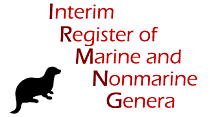
| Intro | | Search taxa | | Taxon tree | | Search literature | | Taxon match | | Homonyms | | Statistics | | Webservice | | Manual | | FAQ | | LifeWatch | | Download | | Log in |
IRMNG name detailsDimorpha A. Gruber, 1881
1307096 (urn:lsid:irmng.org:taxname:1307096)
unaccepted (junior homonym and synonym)
Genus
recent only
Z. wiss. Zool., 36
page(s): 447 [details]
Taxonomic remark Junior homonym of Dimorpha Jurine, 1807 (Hymenoptera), Dimorpha Gray, 1840 (Mollusca), and Dimorpha Hodson, 1841 (Aves). ...
Taxonomic remark Junior homonym of Dimorpha Jurine, 1807 (Hymenoptera), Dimorpha Gray, 1840 (Mollusca), and Dimorpha Hodson, 1841 (Aves). Bass et al., 2009 state that Gruber's original material of the type species, Dimorpha mutans, is poorly described and probably unidentifiable, and select a different strain previously identified as "Dimorpha mutans" (but possibly different) to be the type of their new genus Heliomorpha, with the new name H. mucosa. [details]
IRMNG (2021). Dimorpha A. Gruber, 1881. Accessed at: https://irmng.org/aphia.php?p=taxdetails&id=1307096 on 2025-04-06
Date action by
original description
Z. wiss. Zool., 36
page(s): 447 [details] basis of record Neave, S. A. and successors. (1939-2004). Nomenclator Zoologicus, vols. 1-10 online. [developed by uBio, hosted online at MBLWHOI Library]. Previously at http://ubio.org/NomenclatorZoologicus/ (URL no longer current). , available online at https://insecta.bio.spbu.ru/z/nomenclator_zoologicus_PDF.htm [details] basis of record SN2000/Myl'nikov & Karpov, 2004 [details] basis of record Farr, E. R.; Zijlstra, G. (eds). (1996-current). Index Nominum Genericorum (ING). A compilation of generic names published for organisms covered by the ICN: International Code of Nomenclature for Algae, Fungi, and Plants. [previously: organisms covered by the International Code for Botanical Nomenclature] (2007 version). , available online at https://naturalhistory2.si.edu/botany/ing/ [details] source of synonymy Bass, D.; Chao, E. E.-Y.; Nikolaev, S.; Yabuki, A.; Ishida, K.-I.; Berney, C.; Pakzad, U.; Wylezich, C.; Cavalier-Smith, T. (2009). Phylogeny of novel naked filose and reticulose Cercozoa: Granofilosea cl. n. and Proteomyxidea revised. <em>Protist.</em> 160(1): 75-109., available online at https://doi.org/10.1016/j.protis.2008.07.002 note: refer note [details] name verified source Farr, E. R.; Zijlstra, G. (eds). (1996-current). Index Nominum Genericorum (ING). A compilation of generic names published for organisms covered by the ICN: International Code of Nomenclature for Algae, Fungi, and Plants. [previously: organisms covered by the International Code for Botanical Nomenclature] (2007 version). , available online at https://naturalhistory2.si.edu/botany/ing/ [details] extant flag source SN2000/Myl'nikov & Karpov, 2004 [details] habitat flag source as per family [details] Unreviewed
Nomenclatural status invalid [details]Taxonomic remark Junior homonym of Dimorpha Jurine, 1807 (Hymenoptera), Dimorpha Gray, 1840 (Mollusca), and Dimorpha Hodson, 1841 (Aves). Bass et al., 2009 state that Gruber's original material of the type species, Dimorpha mutans, is poorly described and probably unidentifiable, and select a different strain previously identified as "Dimorpha mutans" (but possibly different) to be the type of their new genus Heliomorpha, with the new name H. mucosa. [details] |